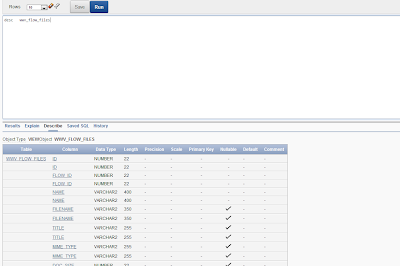Once you are done with installing your Oracle DB instance ( 11g or 10g ) , the next step is to make sure your Oracle APEX is kick started .
1) Make sure your Oracle Database is up and running .
2) Make sure your default port for the webserver that is (8080) is not occupied by any other product .
3) As the Oracle Database already comes with oracle XML DB and Oracle embedded plsql gateway server , you actually need not bother about configuring the apex , as APEX uses the embedded plsql gateway as the default Application server .
4) There are many default scripts which comes with oracle apex which can be used for installing , configuring or adminsitrting or customizing the settings of the oracle apex .
C:\Oracle_home\APEX\ ---- you will find many sql scripts which starts with the apex_version_no_script_description.sql
EX:- apxldimg.sql this is used for loading the images of the application developer of the apex during the apex installation from scratch or it upgradation .
5) One the files is apxconf.sql , this is used for configuring the APEX .
When you run this particular command , you will be shown the default port no which is being used or available :- 8080 .
Then you will be asked to enter the password for the APEX ADMIN :- " enter the password".
Then you need to reneter the password for the confirmation again : " renter the password " .
Note this password will be the admin password for you default workspace of apex thats nothing but ( Internal ) .
You will be asked to enter the port , incase you wanna continue with the same default port then u can enter (8080) as you port no ,else you can change for any other .
[oracle@db11gr2 apex]$ cd $ORACLE_HOME/apex
[oracle@db11gr2 apex]$ sqlplus /nolog
SQL*Plus: Release 11.2.0.1.0 Production on Sun Mar 11 00:48:32 2012
Copyright (c) 1982, 2009, Oracle. All rights reserved.
SQL> connect sys as sysdba
Enter password:
Connected.
SQL>
SQL>
SQL>
SQL> @apxconf
PORT
----------
8080
Enter values below for the XDB HTTP listener port and the password for the Application Express ADMIN user.
Default values are in brackets [ ].
Press Enter to accept the default value.
Enter a password for the ADMIN user []
Enter a port for the XDB HTTP listener [ 8080]
...changing HTTP Port
PL/SQL procedure successfully completed.
PL/SQL procedure successfully completed.
Session altered.
...changing password for ADMIN
PL/SQL procedure successfully completed.
Commit complete.
6) Using the Following Comand cross verify whether your web server is up and running .
SQL> SELECT DBMS_XDB.GETHTTPPORT FROM DUAL;
GETHTTPPORT
-----------
8080
You can mak apex down , by runnnig the comman
SQL>EXEC DBMS_XDB.SETHTTPPORT(0
);
SQL>EXEC DBMS_XDB.SETHTTPPORT(8080
);
again makes the Oracle APEX Up .
7) Now login into oracle apex instance as
http://localhost:8080/apex/apex_admin
or
http://localhost:8080/apex
Workspace:- Internal
User:- Admin
Password :- enter admin password .
Now create your development workspace ,schemas and users,
8)Incase you wanna use the pdf printing functionality or email fucntionality then you need to run this package , the package exists in the installation document , kindly! go thru it once .
DECLARE
ACL_PATH VARCHAR2(4000);
ACL_ID RAW(16);
BEGIN
-- Look for the ACL currently assigned to '*' and give APEX_030200
-- the "connect" privilege if APEX_030200 does not have the privilege yet.
SELECT ACL INTO ACL_PATH FROM DBA_NETWORK_ACLS
WHERE HOST = '*' AND LOWER_PORT IS NULL AND UPPER_PORT IS NULL;
-- Before checking the privilege, ensure that the ACL is valid
-- (for example, does not contain stale references to dropped users).
-- If it does, the following exception will be raised:
--
-- ORA-44416: Invalid ACL: Unresolved principal 'APEX_030200'
-- ORA-06512: at "XDB.DBMS_XDBZ", line ...
--
SELECT SYS_OP_R2O(extractValue(P.RES, '/Resource/XMLRef')) INTO ACL_ID
FROM XDB.XDB$ACL A, PATH_VIEW P
WHERE extractValue(P.RES, '/Resource/XMLRef') = REF(A) AND
EQUALS_PATH(P.RES, ACL_PATH) = 1;
DBMS_XDBZ.ValidateACL(ACL_ID);
IF DBMS_NETWORK_ACL_ADMIN.CHECK_PRIVILEGE(ACL_PATH, 'APEX_030200',
'connect') IS NULL THEN
DBMS_NETWORK_ACL_ADMIN.ADD_PRIVILEGE(ACL_PATH,
'APEX_030200', TRUE, 'connect');
END IF;
EXCEPTION
-- When no ACL has been assigned to '*'.
WHEN NO_DATA_FOUND THEN
DBMS_NETWORK_ACL_ADMIN.CREATE_ACL('power_users.xml',
'ACL that lets power users to connect to everywhere',
'APEX_030200', TRUE, 'connect');
DBMS_NETWORK_ACL_ADMIN.ASSIGN_ACL('power_users.xml','*');
END;
/
COMMIT;







